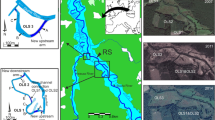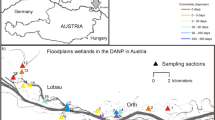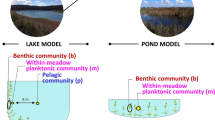Abstract
Despite increasing knowledge of the ecological interactions between species, the dynamics of anurans in aquatic environments are little explored. Thus, our work aims to assess which factors influence the composition and the ecological interactions of hylid anuran species in oxbow lakes in the middle Purus River, Amazonas state, Brazil. We sampled hylid anurans, macroinvertebrates, and macrophyte along 200-m transects, in three lakes with high, medium, and low connectivity on two occasions, once during a flood and again during drought. Variations in hylid anuran assemblages and their ecological interactions were tested as a function of environmental niche, food resources, connectivity level, and hydrological regime. The availability of environmental resources and the availability of food resources were the best factors that explained the distribution of hylid anurans, which were also highly dependent on the variations between the hydrological regimes. The interactions between anurans, macroinvertebrates, and macrophytes showed a modular and specialized structure, which varied according to the connectivity and hydrological regimes of the lakes. Connectance showed an increasing trend from high to low connectivity lakes, suggesting that anurans had low trophic and environmental specialization in lakes with low connectivity. Hylids found in the lake of medium connectivity had higher values of trophic specialization and modularity. Our results illustrate the role of river–lake connectivity and annual hydrological cycle to maintain the aquatic biota and their interactions, and highlight the importance of floating meadows for the maintenance of biodiversity in floodplains.




Similar content being viewed by others
Data Availability
All data produced from this study are provided in this manuscript.
References
Almeida-Neto M, Ulrich W (2011) A straightforward computational approach for measuring nestedness using quantitative matrices. Environmental Modelling & Software 26:173–178
Almeida-Neto M, Guimaraes P, Guimaraes PR, Loyola RD, Ulrich W (2008) A consistent metric for nestedness analysis in ecological systems: reconciling concept and measurement. Oikos 117:1227–1239
Angelis CF, Waichaman AV, Silva AEP, Machado LAT (2008) Influência da precipitação na qualidade da água do Rio Purus. Acta Amazonica 38:733–742
Araujo AC, Martín González AM, Sandel B, Maruyama PK, Fischer R, Vizentin-Bugoni J, de Araújo FP, Coelho AG, Faria RR, Kohler G (2018) Spatial distance and climate determine modularity in a cross-biomes plant–hummingbird interaction network in Brazil. Journal of Biogeography 45:1846–1858
Bascompte J, Jordano P, Melián CJ, Olesen JM (2003) The nested assembly of plant–animal mutualistic networks. Proceedings of the National Academy of Sciences of the United States of America 100(16):9383–9387
Barabási AL (2016) Network science. Cambridge University Press, Cambridge, p 475
Beckett SJ (2016) Improved community detection in weighted bipartite networks. Royal Society Open Science 3:140536. https://doi.org/10.1098/rsos.140536
Begon M, Harper JL, Townsend CR (2006) Ecology: From individuals to ecosystems, 4th edn. Blackwell Publishing, Oxford, p 759
Berlow EL, Neutel A, Cohen JE, De Ruiter PC, Ebenman B, Emmerson M, Fox JW, Jansen VAA, Jones JI, Kokkoris GD, Logofet DO, Mckane AJ, Montoya JM, Petchey O (2004) Interaction strengths in food webs: issues and opportunities. Journal of Animal Ecology 73:585–598
Blanchet FG, Legendre P, Borcard D (2008) Forward selection of explanatory variables. Ecology 89:2623–2632
Blüthgen N, Menzel F, Blüthgen N (2006) Measuring specialization in species interaction networks. BMC Ecology 6. https://doi.org/10.1186/1472-6785-6-9
Böning P, Wolf S, Upton K, Menin M, Venegas PJ, Lötters S (2017) Amphibian diversity and its turnover in floating meadows along the Amazon river. Salamandra 53(3):379–388
Ceron K, Oliveira-Santos LGR, Souza CS, Mesquita DO, Caldas FLS, Araujo AC, Santana DJ (2019) Global patterns in anuran–prey networks: structure mediated by latitude. Oikos 128:1537–1548
Crump ML, Scott NJ Jr (1994) Standard Techniques for Inventory and Monitoring – Visual Encounters Surveys. In: Heyer WR, Donnely MA, McDiarmid RW, Hayek LC, Foster MS (eds) Measuring and monitoring biological diversity – standard methods for amphibians. Smithsonian Institution Press, London, UK, pp 84–91
da Fonte LF, Latombe G, Gordo M, Menin M, Almeida AP, Hui C, Lötters S (2021) Amphibian diversity in the Amazonian floating meadows:a Hanski core-satellite species system. Ecography 44:1–16
Dalsgaard B, Schleuning M, Maruyama PK, Dehling DM, Sonne J, Vizentin-Bugoni JZ, T.B., Fjeldså J, Böhning-Gaese K, Rahbek C, (2017) Opposed latitudinal patterns of network- derived and dietary specialization in avian plant–frugivore interaction systems. Ecography 40:1395–1401
De Montis A, Caschili S, Mulas M, Modica G, Ganciu A, Bardi A, Ledda A, Dessena L, Laudari L, Fichera CR (2016) Urban–rural ecological networks for landscape planning. Land Use Policy 50:312–327
Dormann CF, Gruber B, Fründ J (2008) Introducing the bipartite package: analysing ecological networks. R News 8:8–11
Dormann CF, Fründ J, Blüthgen N, Gruber B (2009) Indices, graphs and null models: analyzing bipartite ecological networks. The Open Ecology Journal 2:7–24
Dou P, Xie T, Li S, Bai J, Cui B (2020) A Network Perspective to Evaluate Hydrological Connectivity Effects on Macroinvertebrate Assemblages. Wetlands 40:2837–2848
Dray S, Bauman D, Blanchet G, Bocard D, Clappe S, Guenard G, Jombart T, Larocque G, Legendre P, Madi N, Wagner HH (2020) adespatial: Multivariate Multiscale Spatial Analysis. R package version 0.3–8. https://CRAN.R-project.org/package=adespatial
Dray S, Legendre P, Blanchet G (2016) packfor: Forward Selection with permutation (Canoco p.46). R package version 0.0–8/r136. https://R-Forge.R-project.org/projects/sedar/
Dray S, Pélissier R, Couteron P, Fortin MJ, Legendre P, Peres-Neto P.R, Bellier E. Bivand R, Blanchet FG, Cáceres M, Dufour AB, Heegaard E, Jombart T Munoz F, Oksanen J. Thioulouse J, Wagner HH (2012) Community ecology in the age of multivariate multiscale spatial analysis. Ecol. Monographs 82. https://doi.org/10.1890/11-1183.1
Duellman WE (1978) The biology of an Equatorial herpetofauna in Amazonian Ecuador. University of Kansas, Lawrence, Kansas., p 352
Duellman WE (2005) Cusco Amazónico: the lives of amphibians and reptiles in an Amazonian rainforest. Cornell University Press, Ithaca, p 472
Duellman WE, Trueb L (1994) Biology of amphibians. The Johns Hopkins University Press, Baltimore and London., p 670
Emlen JM (1966) The role of time and energy in food preference. The American Naturalist 100:611–617
Fisher DN, Pruitt JN (2020) Insights from the study of complex systems for the ecology and evolution of animal populations. Current Zoology 66:1–14
Flora do Brasil (2020) Jardim Botânico do Rio de Janeiro. Disponível em: <http://floradobrasil.jbrj.gov.br/>. Acesso em: 30 set. 2020
Fortin MJ, Dale MR, Brimacombe C (2021) Network ecology in dynamic landscapes. Proceedings of the Royal Society B: Biological Sciences 288:20201889
Ganança PHS Jr, Kawashita-Ribeiro RA, Vasconcelos Neto LB, Santos Júnior IA, Guedes DS, de Fraga DSG (2021) Habitats determining local frog assemblages within aquatic macrophyte meadows in Amazonia, through species traits filtering. Austral Ecology 46(4):574–587
Guimarães P Jr (2020) The Structure of Ecological Networks Across Levels of Organization. Annual Review of Ecology, Evolution, and Systematics 51:433–460
Guterres MG, Marmontel M, Ayub DM, Singer RF, Singer RB (2008) Anatomia E Morfologia Des Plantas Aquáticas Da Amazônia (Utilizadas Como Potencial Alimento Por Peixe-Boi Amazônico). Belem/Pa; 1ª Edição
Hamada N, Nessimian JL, Querino RB (2014) Insetos aquáticos na Amazonia brasileira: taxonomia, biologia e ecologia/Editores Neusa Hamada, Jorge Luiz Nessimian, Ranyse Barbosa Querino. Editora do INPA, Manaus, pp 724
Hill MJ, Biggs J, Thornhill I, Briers RA, Gledhill DG, White JC, Woord PJ, Hassall C (2016) Urban ponds as an aquatic biodiversity resource in modified landscapes. Global Change Biology 23(3):986–999
Hödl W (1977) Call differences and calling site segregation in Anuran Species from central Amazonian floating meadows. Oecologia 28:351–563
Hoogmoed MS (1993) The herpetofauna of floating meadows. In: Ouboter PE (ed) The Freshwater Ecosystems of Suriname. Springer, Dordrecht Academic Publishers, Monographiae Biologicae, pp 199–213
Hubbell SP (2001) The unified neutral theory of biodiversity and biogeography. Princeton University Press, Princeton, p 392
Ings TC, Montoya JM, Bascompte J, Blüthgen N, Brown L, Dormann CF, Edwards F, Figueroa D, Jacob U, Jones JI, Lauridsen RB, Ledger ME, Lewis HM, Olesen JM, van Veen FJF, Warren PH, Woodward G (2009) Ecological networks – beyond food webs. Journal of Animal Ecology 78:253–269
Jones PE, Consuegra S, Börger L, Jones J, Garcia de Leaniz C (2020) Impacts of artificial barriers on the connectivity and dispersal of vascular macrophytes in rivers: a critical review. Freshwater Biology 65:1165–1180
Jordano P (1987) Patterns of mutualistic interactions in pollination and seed dispersal: connectance, dependence asymmetries and coevolution. The American Naturalist 129:657–677
Junk WJ, Bayley PB, Sparks RE (1989) The flood pulse concept in river-floodplain systems. In: Dogde DP (ed) Proceedings of the International Large River Symposium, Special Publications on Canadian Fishery and Aquatic Sciences. NRC Research Press, Ottawa, pp 110–127
Junk WJ, Piedade MTF, Lourival R, Wittmann F, Kandus P, Lacerda LD, Bozelli RL, Esteves FA, Nunes Da Cunha C, Maltchik L, Schöngart J, Schaeffernovelli Y, Agostinho AA (2014) Brazilian wetlands: their definition, delineation, and classification for research, sustainable management, and protection. Aquatic Conservation: Marine and Freshwater Ecosystems 24:5–22
Köppen W (1948) Climatologia: com um estudio de los climas de la tierra. Fondo de Cultura Econômica, México, pp 127–144
Legendre P, Legendre L (2012) Numerical Ecology. Elsevier, Amsterdam., p 1006
Liu X, Murata T (2010) Advanced modularity–specialized label propagation algorithm for detecting communities in networks. Physica A: Statistical Mechanics and its Applications 389:1493–1500
López JA, Scarabotti PA, Medrano MC, Ghidardi R (2009) Is the red spotted green frog Hypsiboas punctatus (Anura: Hylidae) selecting its preys? The importance of prey availability. Revista de Biología Tropical 57:847–857
Luz-Agostinho KDG, Agostinho AA, Gomes LC, Júlio HF, Fugi R (2009) Effects of flooding regime on the feeding activity and body condition of piscivorous fish in the Upper Paraná River floodplain. Brazilian Journal of Biology 69:481–490
MacDonald AAM, Banville F, Poisot T (2020) Revisiting the links-species scaling relationship in food webs. Patterns 1(7):100079
Maruyama PK, Vizentin-Bugoni J, Oliveira GM, Oliveira PE, Dalsgaard B (2014) Morphological and Spatio-Temporal Mismatches Shape a Neotropical Savanna Plant-Hummingbird Network. Biotropica 46:740–747
Mormul RP, Thomaz SM, Vieira LJS (2013) Richness and composition of macrophyte assemblages in four Amazonian lakes. Acta Scientiarum - Biological Sciences 35(3):343–350
Moura Júnior EG, Paiva RMS, Ferreira AC, Pacopahyba LD, Tavares AS, Ferreira FA, Pott A (2015) Updated checklist of aquatic macrophytes from Northern Brazil. Acta Amazonica 45(2):111–132
Oksanen J, Guillaume Blanchet F, Friendly M, Kindt R, Legendre P, McGlinn D, Minchin PR, O’Hara RB, Simpson GL, Solymos P, Stevens MHH, Szoecs E, Wagner H (2020) vegan: community ecology package. R package version 2.5-7. https://CRAN.R-project.org/package=vegan
Olesen JM, Jordano P (2002) Geographic patterns in plant–pollinator mutualistic networks. Ecology 83:2416–2424
Patefield WM (1981) Algorithm AS 159: an efficient method of generating random R×C tables with given row and column totals. Journal of the Royal Statistical Society 30:91–97
Peiró DF, Alves RG (2006) Insetos aquáticos associados a macrófitas da região litoral da represa do Ribeirão das Anhumas (município de Américo Brasiliense, São Paulo, Brasil). Biota Neotropica 6:1–9
Pelicice FM, Agostinho AA (2006) Feeding ecology of fishes associated with Egeria spp. patches in a tropical reservoir, Brazil. Ecology of Freshwater Fish 15:10–19
Peres-Neto PR, Legendre P, Dray S, Borcard D (2006) Variation partitioning of species data matrices: estimation and comparison of fractions. Ecology 87(10):2614–2625
Petry P, Bayley PB, Markle DF (2003) Relationships between fish assemblages, macrophytes and environmental gradients in the Amazon River floodplain. Journal of Fish Biology 63:547–579
Petsch DK (2016) Causes and consequences of biotic homogenization in freshwater ecosystems. International Review of Hydrobiology 101:113–122
Poi de Neiff A (2003) Macroinvertebrates living on Eichhornia azurea Kunth in the Paraguay River. Acta Limnologica Brasiliensia 15(1):55–63
Projeto Radambrasil, Folha SC (1976) 19 Rio Branco: geologia, geomorfologia, pedologia, vegetacao, uso potencial da terra. Departamento Nacional da Produção Mineral, (Levantamento de recursos naturais, 12), Rio de Janeiro, pp 457
R Core Team (2020) R: a language and environment for statistical computing. R Foundation for Statistical Computing, Vienna. https://www.R-project.org/
Ramalho WP, Machado IF, Vieira LJS (2018) Do flood pulses structure amphibian communities in floodplain environments? Biotropica 50:338–345
Ramalho WP, Andrade MS, Matos LRA, Vieira LJS (2016) Amphibians of varzea environments and floating meadows of the oxbow lakes of the Middle Purus River, Amazonas, Brazil. Biota Neotropica 16:1–15
Ríos-Villamizar EA, Junior AFM, Waichman AV (2011) Caracterização físico-química das águas e desmatamento na bacia do rio Purus, Amazônia brasileira Ocidental. Revista Geográfica Acadêmica 5:54–56
Robinson BW, Wilson DS (1998) Optimal Foraging, Specialization, and a Solution to Liem’s Paradox. The American Naturalist 151:223–235
Scarabotti PA, López JA, Pouilly M (2011) Flood pulse and the dynamics of fish assemblage structure from neotropical floodplain lakes. Ecology of Freshwater Fish 20:605–618
Schleuning M, Fründ J, Klein AM, Abrahamczyk S, Alarcón R, Albrecht M, Andersson GK, Bazarian S, Böhning-Gaese K, Bommarco R (2012) Specialization of mutualistic interaction networks decreases toward tropical latitudes. Current Biology 22:1925–1931
Schiesari L, Zuanon J, Azevedo-Ramos C, Garcia M, Gordo M, Messias M, Monteiro Vieira E (2003) Macrophyte rafts as dispersal vectors for fishes and amphibians in the Lower Solimões River, Central Amazon. Journal of Tropical Ecology 19:333–336
Simon MP, Toft CA (1991) Diet specialization in small vertebrates: mite-eating in frogs. Oikos 61:263–278
Sioli H (1991) Amazônia: Fundamentos da Ecologia da Maior Região de Florestas Tropicais, 3 edn. Vozes, Rio de Janeiro
SPLink (2018) Centro de Referência em Informação Ambiental, CRIA - Fundação de Amparo à Pesquisa do Estado de São Paulo, (www.splink.cria.org.br). Acessado em 25/09/2018.
St. Pierre JI, Kovalenko KE, (2014) Effect of habitat complexity attributes on species richness. Ecosphere 5(2):1–10
Thiers B (2018) Index Herbariorum: A global directory of public herbaria and associated staff. New York Botanical Garden’s Virtual Herbarium. (http://sweetgum.nybg.org/science/ih/). Acessado em 14/11/2018.
Thomaz SM, Bini LM, Bozelli RL (2007) Floods increase similarity among aquatic habitats in river-floodplain systems. Hydrobiologia 579:1–13
Tylianakis JM, Morris RJ (2017) Ecological networks across environmental gradients. Annual Review of Ecology, Evolution, and Systematics 48:25–48
Upton K, Warren-Thomas E, Rogers I, Docherty E (2014) Amphibian diversity on floating meadows in flooded forests of the Peruvian Amazon. Herpetological Review 45:209–212
Upton K, Steadman J, Popplewell D, Rogers I, Wills A (2011) Amazonian frog diversity and microhabitat use. Herpetological Bulletin 45:209–212
Van Den Brink FWB, Van Der Velde G, Buijse AD, Klink AG (1996) Biodiversity of the Lower Rhine and Meuse river-floodplains: its significance for ecological management. Netherlands Journal of Ecology 30:129–149
Ward JV, Tockner L (2001) Biodiversity: towards a unifying theme for river ecology. Freshwater Biology 46:807–819
Zanata TB, Dalsgaard B, Passos FC et al (2017) Global patterns of interaction specialization in bird–flower networks. Journal of Biogeography 44:1891–1910
Acknowledgements
We thank the CAPES (Coordenação de Aperfeiçoamento de Pessoal de Nível Superior) for scholarships awarded, the Programa de Pós-Graduação em Ecologia e Manejo de Recursos Naturais for financial support via PROAP; Guilherme Cabral for his help during data collection and identification of macrophytes species; to Ednelson for the excellent work as a boatman and local guide, the local residents for the housing and support in the collections, and the graduate students Programa de Pós-Graduação em Ecologia e Manejo de Recursos Naturais of the Universidade Federal do Acre for helping during fieldwork.
Funding
This study was financed in part by the Coordenação de Aperfeiçoamento de Pessoal de Nível Superior—Brasil (CAPES), which granted scholarships to WPR (proc. 88882.448043/2019–01), LRAM, FVA and KC, and by the Programa de Pós-Graduação em Ecologia e Manejo de Recursos Naturais which provided financial support via Programa de Apoio à Pós-Graduação (PROAP). P. Luna wishes to thank Consejo Nacional de Ciência and Technology for scholarship (71366). FVA thanks CNPQ by PCI-MCTIC/MPEG (302198/2020-2). KC thanks São Paulo Research Foundation (FAPESP) by the grant #2020/12558-0. WPR thanks to CNPq and Fundação de Amparo à Pesquisa do Estado de Goiás—FAPEG for the Regional Scientific Development Scholarship (Process #317724/2021-5).
Author information
Authors and Affiliations
Contributions
All authors contributed to the conceptualization and design of the project. LRAM and WPR collected the data, performed the data analysis, and led the writing of the text. FVA, KC, and PL provided additional expertise on interaction network, performed data analysis, and wrote the text. LRV provided additional expertise on hydrology and river-lake connectivity. LJSV assisted with data interpretation and writing, and supervised this research. All authors critiqued the manuscript and gave final approval for submission.
Corresponding author
Ethics declarations
Conflicts of interest/Competing interests
Authors declare that they have no conflict of interest.
Consent to Participate
Not applicable.
Consent for Publication
Not applicable.
Ethics Approval
This study follows the guidelines and permission to handle and collect animals given by the Ministério do Meio Ambiente / Instituto Chico Mendes de Conservação da Biodiversidade (#57791–1).
Additional information
Publisher’s Note
Springer Nature remains neutral with regard to jurisdictional claims in published maps and institutional affiliations.
Supplementary Information
Below is the link to the electronic supplementary material.
Rights and permissions
About this article
Cite this article
de Matos, L.R.A., Ramalho, W.P., de Arruda, F.V. et al. Environmental Drivers and Network Structure of Hylid Anurans (Amphibia: Hylidae) in Floating Meadows from Amazonian Oxbow Lakes. Wetlands 42, 21 (2022). https://doi.org/10.1007/s13157-022-01541-x
Received:
Accepted:
Published:
DOI: https://doi.org/10.1007/s13157-022-01541-x




